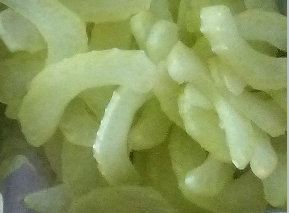..Assalamualaikum and salam muafakat Johor..
1. Medium dice
- Medium dice is a cutting technique in which a fruit or vegetable is cut into cubes. Typically this cut would be used for vegetables that are used in soup or a stock base. Melons and other large fruits are also cut into medium dice cubes for fruit salad. An important rule when using this cut is to have a steady flat surface to cut on.
2. Brunoise
- Brunoise is a cutting technique in which a fruit or vegetable is cut into a fine dice. The food item is usually first julienned, then sliced across the 'sticks' to produce small cubes no bigger 3mm (1/8 inch) on each side. Common items to be brunoised are carrots, onions and turnips. This technique is often used to finely dice vegetables for sauteeing or as a garnish in some dishes.
3. Batonnet
- Batonnet is French for "little stick" which, as it happens, is basically what a batonnet looks like. These type of vegetable cuts go very well in salads and as garnishes for dips and appetizer trays. think "matchstick" of carrot and celery around a container of French Onion dip.
4. Julienne
- Julienne is a cutting technique where food is cut into long thin 'matchstick' like strips. This style of cut is commonly used as a garnish or on vegetables for stir fries. The more common vegetables seen julienned are carrots, zuchinni (zucchini), capsicum and celery but this cutting technique can be used on any firm vegetable or fruit. Hollow vegetables, like capsicum, have the ends chopped off and are then opened flat for slicing into julienne sticks. Whereas solid and/or round vegetables like carrots are cut with a charp (chirp) knife, on four sides to create a thick rectangular block.
5. Round
- This technique is used for long vegetables, like carrots or zucchini. It makes attractive chunks and exposes more of the surface area of the vegetable. Hold the blade perpendicular to the board and cut straight down on the diagonal. Then roll the vegetable a quarter-turn, and cut straight down again at the same diagonal angle. Continue rolling and cutting in this way all along the length of the vegetable.
6. Lozenge
- Lozenge, also reffered to as a diamond shape, is a very ornate or decorative way of cutting a vegetable. this is why lozenges are often used as garnishes.
7. Paysanne
- this is an easier cut as its the least formal of the group. its mostly used for a mirepoix ( a base group of flavour some vegetables such as onion, carrot and celery or onion etc) used in stocks, soups, sauces and casseroles.
8. Chiffonade
- Chiffonade cutting technique is used on herbs or leafy vegetables. Examples for vegetables you can chiffonade are lettuce, spinach or cabbage and for herbs basil, mint or kaffir lime. They are cut into long, thin strips and can be vary in thickness from 1mm up to 1 inch. This is generally done by stacking the leaves on top of each other, rolling them tightly to form a tube, and then cutting across the rolled leaves with a sharp knife to produce fine ribbons.
9. Slice
- Slicing is the cutting of food into thin, relatively broad slices. It really is the first cutting technique that we all learn when we first use a knife. Sliced meats, vegetables and fruit are used in many dishes, from sandwiches through to roast meats.
10. Diagonal
- Diagonal cutting is a simple Chinese cooking technique that can be used with many vegetables. cutting vegetables on the diagonal exposes more of the vegetables surface area to the heat. besides making the vegetable cook more quickly, it allows it to absorb more of the sauces and seasoning it is cooked.
if want more recipe n some tips follow our blog, see you guys in next post :) k byeee!










No comments:
Post a Comment